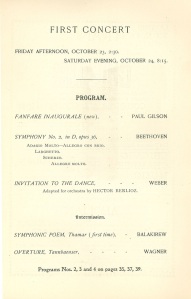This week’s Beyond the Score presentation offers an in-depth look at Nikolai Rimsky-Korsakov’s symphonic suite Sheherazade, op. 35, first performed (twice, actually) by the Chicago Orchestra during the 1897-98 season.
One of Rimsky-Korsakov’s influences for Sheherazade was a composition by fellow Russian Mily Alexeivich Balakirev, entitled Tamara. Considered by many to be Balakirev’s greatest work, this symphonic poem is also a hallmark example of Orientalism in music. Theodore Thomas led the Orchestra in the United States premiere of Tamara on October 23, 1896, and a first edition of the score (with a spectacular cover) is in the Thomas collection, here in the Rosenthal Archives.
Arthur Mees’s program note for the first performances is here, and on October 24, 1896, the Chicago Daily Tribune offered the following review:
“The program opened with one of the many novelties by young composers to be played this season, Paul Gilson’s Fanfare Inaugurale, and comprised in the second part Balakireff’s symphonic poem Thamar. The latter, naturally of main importance, is first of all an intellectual piece of writing. The poem upon which it is founded—the myth of the cruel Queen of the Georgians, Thamar—is followed in an impressionistic way. There is the wealth of fancy almost Eastern, which seems a possession of Russian writers generally, and an instrumentation bizarre to the point of barbaric crudeness.
“Yet in this example of Balakireff’s art there is restraint in this final trait: the restraint emanating from thorough intelligence. There it is that there is evidenced the advantage of an early training in a widely opposite direction than music, and while the spontaneity of born musical genius may not shine forth in Thamar, there is the next best thing to it, an intelligence sufficient to greatly disguise the fact. It is above all interesting and unique. There are serious deviations and lack of directness in the following of the story, which it purports to convey, but it is nevertheless characteristic.”



Leave a comment
Comments feed for this article